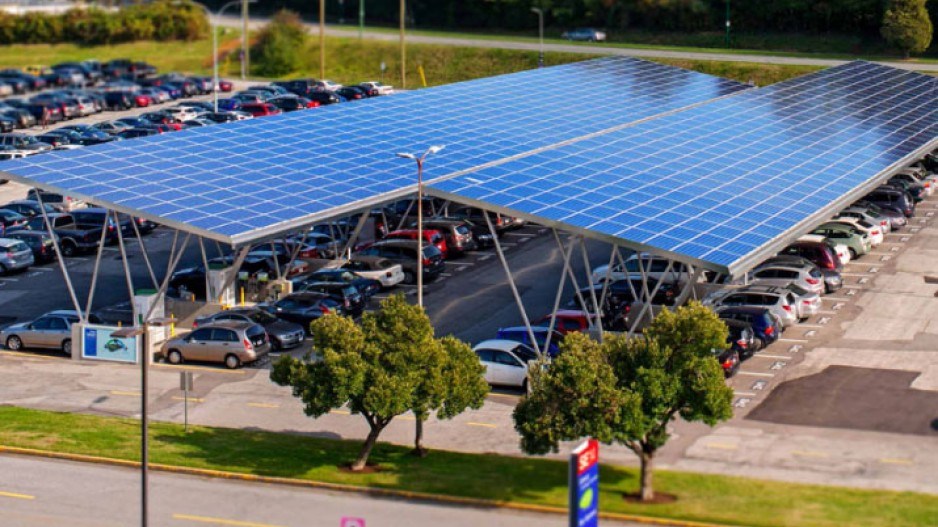While the BC Institute of Technology (BCIT) was showing off its new solar-powered electric vehicle charging station September 14, BC Hydro obliged in the demonstration with an unexpected power outage at the college’s Burnaby campus.
The new Energy Oasis power system just happens to have 500 kilowatts hours (kWh) of lithium-ion battery storage, so it was able to power the PA system and other electronics used at a press conference, according to Hassan Farhangi, BCIT’s director of smart grid research and an adjunct professor at Simon Fraser University.
“We were able to supply the required power from our subsystems,” he said.
That’s not what the Energy Oasis system was designed for, but it’s just one of the benefits it will provide: a backup source of power for the campus.
The new Energy Oasis system has been dubbed the gas station of the future, although there’s no gas involved. It’s an electric vehicle charging station powered by the sun.
An array of 84 solar panels produce up to 250 kWh of electricity per day (about enough power for 30 homes).
A state of art energy management system provides 500 kWh of storage, using lithium-ion batteries, and load balancing.
The solar panels and power storage powers two fast-charging stations for EVs (10 to 20 minutes), and another six slower charging stations (four to six hours).
The new Energy Oasis system was built as a demonstration project with senior government funding ($4.4 million from Natural Resource Canada and $2 million from BC Hydro), and financial and in-kind donations from industry partners: Siemens, Schneider Electric, Panasonic and Car2Go.
“The intention behind this particular subsystem is to try and develop a footprint for the gas stations of the future, or charging stations for electric cars,” Farhangi said.
The Energy Oasis is the newest showpiece of a bigger demonstration project – a self-sufficient microgrid that has been in development since 2007.
Another showpiece of the BCIT microgrid is a net-zero demonstration home that is energy self-sufficient. Power is supplied with rooftop solar panels and a wind turbine.
In total, the microgrid has taken an investment of nearly $30 million.
Universities across Canada send electrical engineering students to the Burnaby campus to learn about microgrids, which are self-contained energy systems that use renewable power, like wind and solar, and do not need to be connected to regular power grids.
In total, the BCIT microgrid generates close to one kWh of electricity per day. That’s about one-sixth of the total power load for the BCIT campus.
The power generated by the Energy Oasis system is intended mostly for charging EVs, but it can also feed surplus power into BC Hydro’s grid. And as Wednesday’s outage proved, it can also be a source of backup power.
“At times, we are actually able to take parts of the campus off (grid power) and supply that using the power we are generating,” Farhangi said.
Although the Energy Oasis system has a practical function – providing students and staff who drive EVs with charging stations – it is intended as a demonstration project for future microgrid development, which is still evolving.
“Our energy systems are going to go through a process of drastic transformation in the next 10 years,” Farhangi said.
“We are going to move away from fossil fuel and have maximum efficiencies in terms of production, integration and use, and a lot of those cannot be done without technologies of this nature.”
"British Columbia is a world leader in clean energy, with 98% of our system already clean or renewable," said BC Hydro CEO
Jessica McDonald. "Solar is a great part of our mix and the Energy Oasis project will make an important contribution to understanding the impact of new technologies on the grid."




